Aikibatto 1 DetailsShiho MAE
DetailsShiho, four directions, is a common concept in iaido, found for example in the first four forms of Omori ryu. It is, of course, a way of preparing for attacks from any directions, which can in a more elaborate training be done by happo, eight directions, the first four being the same as here and the next four in diagonal directions to these. In a shoden basic system, though, there is no need for more than four directions — front, back, left, right.Seiza, the sitting position, is usually the starting point for the first few forms of a iaido kata system, but in Aikibatto shoden, all exercises are performed standing up. This makes better sense in relation to most Aikiken, and also to the way in which swords were used in old Japan. I would not call a swordplay system with walking on one's knees an ideal start for learning the basics of sword moves, especially not for the non-Japanese, unacquainted with suwariwaza, the knee walking.
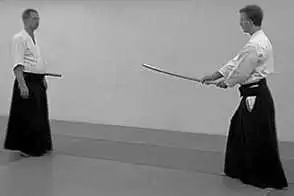 Starting position. Tori at left, uke at right. Mae, front, is the first of the four Shiho, with uke coming straight at tori. In most iaido schools, some kind of mae is the very first form, because of its basic character. Here in Aikibatto it does not deviate much from the iaido standard, except for the taisabaki to the right taking place at the fourth movement, and the consequences of this.
In the taisabaki step to the right, of the fourth movement, it is important to let the left foot follow a bit, so that none of tori's body is in the way of uke's sword when it comes down in the fifth move, not even the ankle or heel of the left foot.
Uke is cutting chudan, to middle level, in movement five, but actually a cut to jodan, high level, or gedan, low level, would work as well — making no difference what so ever to tori. Not even yokomen or kesagiri would cause any complications. That goes for most of the ten Shoden exercises — uke's attack can usually vary without tori having to change any movement. So, in training it can be beneficiary to the awareness of tori, if uke actually changes between cuts — sometimes chudan, sometimes jodan or gedan — but not until tori has developed some confidence in the moves. When uke cuts in movement five, already being cut in the waist at movement four, this would for obvious reasons result in uke tipping forward somewhat, not able to maintain a straight posture. This happens although no actual cutting is done by tori when using a bokken — the move is cutting the posture of uke, the flow of ki through uke's central pillar necessary to keep a straight back and neck when moving quickly or forcefully. The fact that uke will end up bending forward is the reason for the cut in movement six being straight, not diagonal as in kesagiri, but still landing on the side of uke's neck, just as it would by kesagiri, and not on the top of uke's head. Otherwise a kesagiri would no doubt be more efficient.
The men cut of movement six should really be to chudan level, but in partner practice it stops right above the head if uke stands straight, or by the neck if uke is bending forward. Here, no contact is safe, so tori should stop the sword at a proper distance from uke's body. The yielding of the sword to migi no waki, right side, done by uke in movement seven, is not to a proper guard, since that would make it unwise for tori to do noto, shielding the sword. Instead uke's sword drops downward, while moving toward the right side, so that the sword point ends up near the floor, and uke's attitude should be relaxed, calmly surrendering. Having retreated three steps, uke waits for tori to do movements eight to ten. Usually in Aikiken, this ritualized ending is not performed, and it can become tiring at length, but to be able to do it is very good for developing a sharpened awareness and concentration throughout the exercise. The lowering of the sword in movement eight is done slowly, in a spirit of continued domination of the situation. The chudan kamae guard should be alert, with an ability to immediately charge anew.
When a hakama is worn, its top strap can equally well be used instead, so that the bokken will rest on the belt instead of inside of it. There are several ways of doing the noto with a bokken, but this I find to be a good compromise between what's practical with the bokken and what still serves as a preparatory exercise for the proper noto with the real sword.
Iai considerations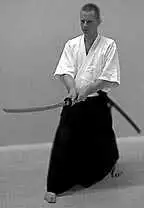 In iai style single training of the tori movements in this exercise, the modifications of the above would be only three: the do cut in movement four should be fully extended, cutting through, and the men of movement six should be cutting through down to chudan level, that is to the chudan kamae position. Finally, in the noto, returning the blade to its scabbard, the left hand stays on the scabbard until the blade is completely shielded, then uses the thumb on the tsuba to press it in the last bit, at the same time as the right hand reaches the kashira, the end piece of the hilt.
In iai style single training of the tori movements in this exercise, the modifications of the above would be only three: the do cut in movement four should be fully extended, cutting through, and the men of movement six should be cutting through down to chudan level, that is to the chudan kamae position. Finally, in the noto, returning the blade to its scabbard, the left hand stays on the scabbard until the blade is completely shielded, then uses the thumb on the tsuba to press it in the last bit, at the same time as the right hand reaches the kashira, the end piece of the hilt.Uke's movements in this exercise are not very meaningful to practice in a iai solo style.
Stefan Stenudd Table of movementsNext exercise© Stefan Stenudd, 2000. You are free to any non-commercial use of this material, without having to ask for my permission. But please refer to this website, when doing so.
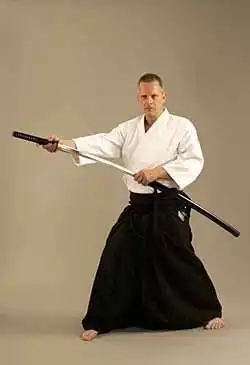
AikibattoIntroductionBackgroundAikibatto BasicsSword exercisesJo staff exercisesSolo video clipsDuo video clipsKen suburiCorrectionsGlossaryVisitor responseShinken, the swordAikibatto — the book
About CookiesMy Other WebsitesCREATION MYTHSMyths in general and myths of creation in particular.
TAOISMThe wisdom of Taoism and the Tao Te Ching, its ancient source.
LIFE ENERGYAn encyclopedia of life energy concepts around the world.
QI ENERGY EXERCISESQi (also spelled chi or ki) explained, with exercises to increase it.
I CHINGThe ancient Chinese system of divination and free online reading.
TAROTTarot card meanings in divination and a free online spread.
ASTROLOGYThe complete horoscope chart and how to read it.
MY AMAZON PAGE
MY YOUTUBE AIKIDO
MY YOUTUBE ART
MY FACEBOOK
MY INSTAGRAM
MY TWITTER
STENUDD PÅ SVENSKA
|
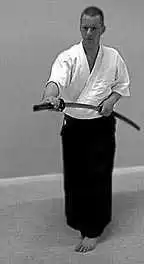 Normally in iaido, nuki tsuke, the draw, finishes with the sword point in front of the left eye of uke, who has not yet drawn the sword, as in mae of Seitei. But here, where uke's sword is already raised, the nuki tsuke is immediately followed by a cut to uke's waist in movement four, right before uke's sword comes down in chudan giri, a cut to middle level.
Normally in iaido, nuki tsuke, the draw, finishes with the sword point in front of the left eye of uke, who has not yet drawn the sword, as in mae of Seitei. But here, where uke's sword is already raised, the nuki tsuke is immediately followed by a cut to uke's waist in movement four, right before uke's sword comes down in chudan giri, a cut to middle level.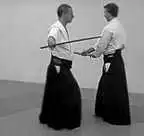 The horizontal cut in movement four is not as easy as it may seem to the beginner, since it needs to be done so that the edge of the sword is exactly in line with the movement, that is completely horizontal, and should strike at the soft waist — between the hip bone and the lowest rib. Here, some contact is both allowed and of benefit, for checking out how the cut is performed. Make sure, beforehand, that the bokken used has no flaws on its surface which might harm uke.
The horizontal cut in movement four is not as easy as it may seem to the beginner, since it needs to be done so that the edge of the sword is exactly in line with the movement, that is completely horizontal, and should strike at the soft waist — between the hip bone and the lowest rib. Here, some contact is both allowed and of benefit, for checking out how the cut is performed. Make sure, beforehand, that the bokken used has no flaws on its surface which might harm uke.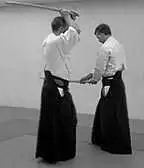 Raising the sword to jodan and turning toward uke in movement six, is done simultaneously — the body turning to its position at the same time as the sword is pulled to the jodan guard of where the body will be at the end of this step. So, at the very same instant when the body has reached its position, so shall the sword have done.
Raising the sword to jodan and turning toward uke in movement six, is done simultaneously — the body turning to its position at the same time as the sword is pulled to the jodan guard of where the body will be at the end of this step. So, at the very same instant when the body has reached its position, so shall the sword have done.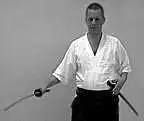 At the chiburi in movement nine, the alertness is thrown away with the imaginary blood on the blade, emptying the mind of the previous duel, with an attitude of opening oneself up. This is the most basic of the many chiburi to be found in iaido. The sword is thrust to the right, the edge of the blade in that exact direction (to get the blood off), and the blade not horizontal, but tipping a little downwards (or the blood would pour down onto tori's sword grip).
At the chiburi in movement nine, the alertness is thrown away with the imaginary blood on the blade, emptying the mind of the previous duel, with an attitude of opening oneself up. This is the most basic of the many chiburi to be found in iaido. The sword is thrust to the right, the edge of the blade in that exact direction (to get the blood off), and the blade not horizontal, but tipping a little downwards (or the blood would pour down onto tori's sword grip). Noto, shielding the sword, is done in just as numerous ways as chiburi, and always related to the sort of chiburi chosen. With a sharp blade one should take care, because it is often in noto that one accidentally cuts oneself.
Noto, shielding the sword, is done in just as numerous ways as chiburi, and always related to the sort of chiburi chosen. With a sharp blade one should take care, because it is often in noto that one accidentally cuts oneself.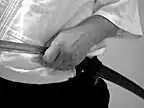 When done with a bokken, the left hand forms into an opening — just as it would on the top of the scabbard, saya — held not by the side of tori's body, but immediately in front of tori's center, tanden. The sword slides with the back of the blade on this opening (more precisely in the track formed by the thumb and index finger) — not to the side, but rather as much forward as possible, extending the tsuka, the hilt, to the front instead of sideways. Not until the point of the bokken enters the opening formed by the left hand, does that hand move back to the side, to pull the belt a bit, for the bokken to be stuck inside of it.
When done with a bokken, the left hand forms into an opening — just as it would on the top of the scabbard, saya — held not by the side of tori's body, but immediately in front of tori's center, tanden. The sword slides with the back of the blade on this opening (more precisely in the track formed by the thumb and index finger) — not to the side, but rather as much forward as possible, extending the tsuka, the hilt, to the front instead of sideways. Not until the point of the bokken enters the opening formed by the left hand, does that hand move back to the side, to pull the belt a bit, for the bokken to be stuck inside of it. When noto is completed, tori moves the left foot forward to the side of the right foot, at the same time sliding with the right hand to the end of the hilt, tsuka, then to fall down to the side of the body in a relaxed way. At this point, tori should have let go of all that went before, as if it never happened, becoming of a completely relaxed state of mind. Then tori walks backwards to the initial position.
When noto is completed, tori moves the left foot forward to the side of the right foot, at the same time sliding with the right hand to the end of the hilt, tsuka, then to fall down to the side of the body in a relaxed way. At this point, tori should have let go of all that went before, as if it never happened, becoming of a completely relaxed state of mind. Then tori walks backwards to the initial position. Aikibatto — Sword Exercises for Aikido Students
Aikibatto — Sword Exercises for Aikido Students